
Abandoned & Little-Known Airfields:
Texas: Wichita Falls area
© 2002, © 2024 by Paul Freeman. Revised 2/13/24.
This site covers airfields in all 50 states: Click here for the site's main menu.
____________________________________________________
Please consider a financial contribution to support the continued growth & operation of this site.
Call Field (revised 2/13/24) - Electra Airport (revised 2/13/24) - Nocona Airport (revised 11/15/22) - Sheppard AF Helicopter Annex #2 (revised 11/2/22)
____________________________________________________
Electra Airport, Wichita Falls, TX
34.054, -98.969 (Northwest of Fort Worth, TX)

Electra Airport, as depicted on the October 1932 Dallas Sectional Chart.
According to the article “Plante & airport was just a little Christmas surprise” in the 12/28/68 Post-Herald Magazine (courtesy of Kimberly Jackson),
pioneer female aviator Jimmie Kolp received a surprise present on Christmas morning 1929:
a white & red Spartan biplane, “gift-wrapped in a 120 acre airport.”
According to an article in the 3/12/21 Wichita Falls Times Record News (courtesy of Richard Warner),
“When Jimmie Kolp was a young woman living in Electra, she looked up & saw an airplane fly over.
That was a rare sight in those days. The pilot was scouting for oil sites. When he landed, Jimmie asked for a ride – and got it.
So began a lifelong passion for Jimmie Kolp – flying. She became the first woman in Wichita County to get her flying license & one of the first 3 in TX.
In 1929 her husband, C.F., who was in the oil business, gave her a surprise Christmas present: a white & Red Spartan biplane with a Wright engine.
The wrapping was 120 acres of pastureland – her own airfield.
For the next 40 years Jimmie devoted herself to women in aviation & civic & philanthropic causes.”
The earliest depiction which has been located of Electra Airport was on the October 1932 Dallas Sectional Chart,
which depicted Electra as a commercial/municipal airport.

The only ground-level photo which has been located of Electra Airport was a circa 1946 photo of airport owner Jimmie Kolp & a Cessna 190 (courtesy of Richard Warner).
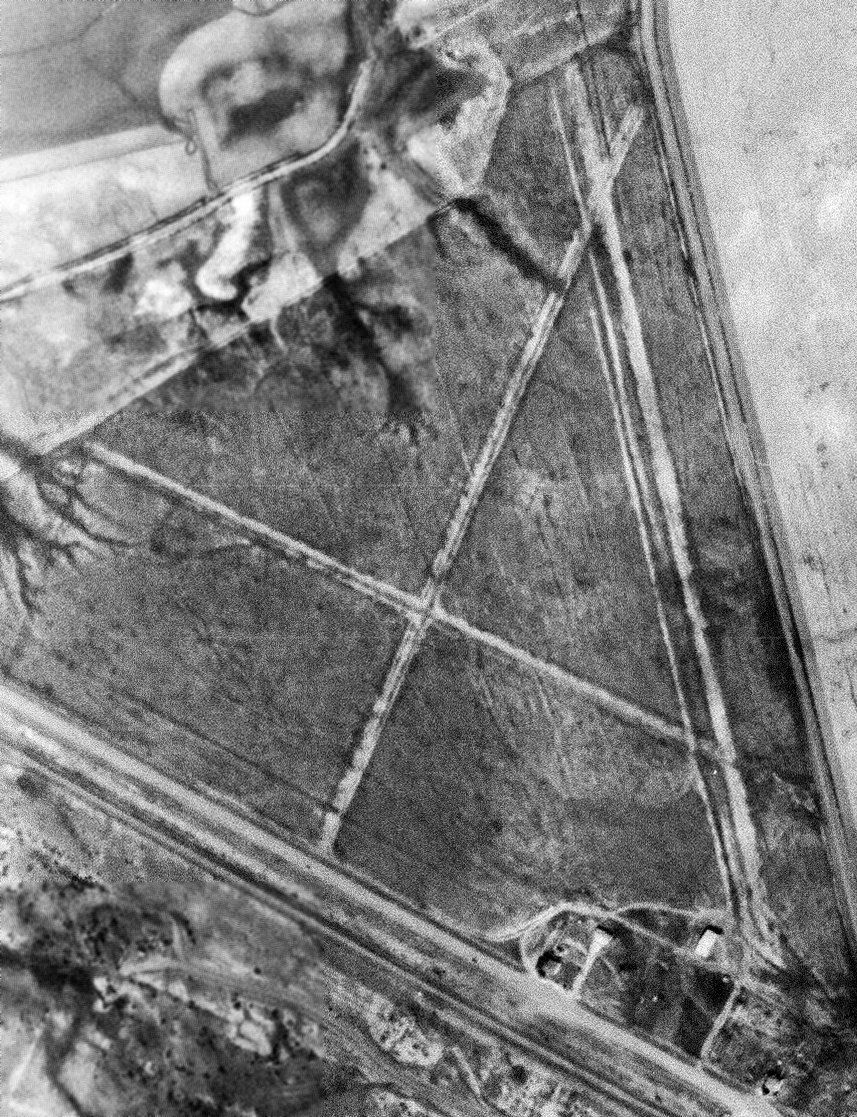
The only aerial photo which has been located of Electra Airport was a 9/5/53 USGS aerial view.
It depicted Electra Airport as having 3 unpaved runways, with a few small buildings (hangars?) on the south side.
It is not apparent if Electra Airport was still in use by this point, as there were no aircraft visible on the field.

The 1958 USGS topo map depicted “Electra Airfield” as having 3 runways & 3 small buildings on the south side.
Richard Warner recalled, “In 1960, when I was 16, my dad managed to get 3 of his friends to give me rides in airplanes, all 3 at the Electra Airport.
Bob Holman took me flying in his Cessna 140. Mr. Parks took me flying in his Mooney, but during takeoff, the door popped open, Mr. Parks tried & failed to close it, so we landed & were done for the day.
On 11/6/60, Jimmie Kolp took some local boys including me flying in her Cessna 195. Wonderful lady, plane & day.
On 8/25/63, I landed a Cessna 172 at the airport & departed the next day.”

The last aeronautical chart depiction which has been located of Electra Airport was on the July 1968 Dallas Sectional Chart.
It depicted Electra Airport as having a 3,100' unpaved runway.
A 1971 aerial photo showed Electra Airport's runways & hangar as remaining intact,
but without any sign of recent aviation use.
Electra Airport was presumably closed (for reasons unknown) at some point between 1968-72,
as it was no longer depicted on the 1972 USGS topo map.
A 1977 aerial view showed no trace of the Electra Airport runways, with the site having been returned to cultivation,
but one hangar remained on the south side.
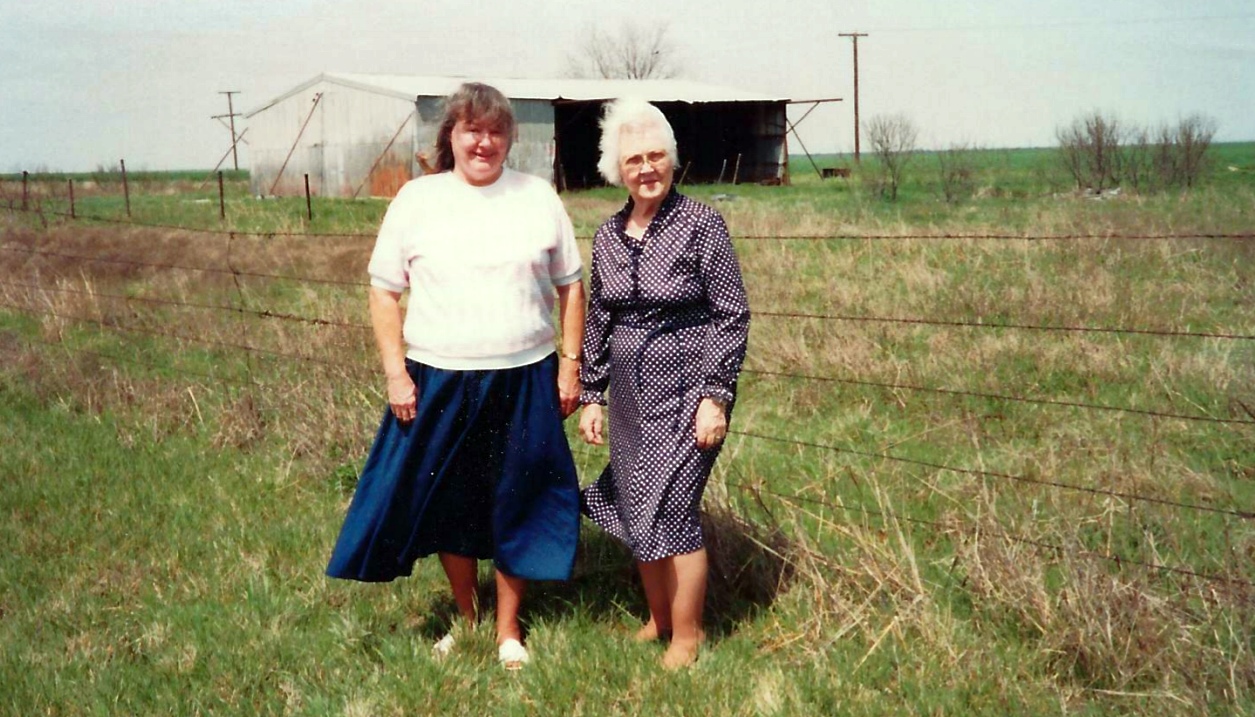
A 9/27/92 photo (courtesy of Kimberly Jackson) of Betty Kidd & Lou Ellen Foster in front of Jimmie Kolp's hangar at the site of Electra Airport.

A 2019 aerial view looking northeast showed no trace of the Electra Airport runways, with the site having been returned to cultivation,
but one hangar remained on the south side.
According to an article in the 3/12/21 Wichita Falls Times Record News (courtesy of Richard Warner),
“Jimmie's name has been largely lost to the generations that followed. That’s about to change.
The Wichita County Historical Commission got approval for a historical marker to permanently enshrine the memory of Jimmie’s contributions.
The marker is made possible through TX's 'Undertold Markers' program, which is intended to tell the stories of people & events that have been mostly forgotten.
Becky Trammell & Elizabeth Hawley spearheaded the effort to get approval for Jimmie's marker.”
“At the time people didn’t want women to fly, but Jimmie did it. She was just one of those women,” said Hawley, who did much of the research on the aviatrix.
She owned 9 airplanes at one time.”
The article continued, “Once details are finished & the marker is cast it will be erected, probably in the summer of 2022.
The question of where to put it was the subject of much discussion.
The Historical Commission decided to place it at Wichita Falls Regional Airport where the greatest number of flying travelers could read it.
Jimmie’s airport was another possibility, but it’s far from many travelers or visitors.
The airfield has returned to pasture & only Jimmie’s hangar still stands, now just a haybarn, battered by the TX winds that sweep across the fields.”
Richard Warner recalled, “I've driven by Electra Airport hundreds of times over the years & watched the field get plowed & the 1 hangar rust & bend to the wind. Fond memories.”

A 2023 photo looking north at Jimmie Kolp's hangar at the site of Electra Airport.
The site of Electra Airport is located northwest of the intersection of Route 287 & County Road 129 North.
Thanks to Kimberly Jackson for pointing out this airfield.
____________________________________________________
Nocona Airport (F48), Nocona, TX
33.774, -97.739 (Northwest of Fort Worth, TX)
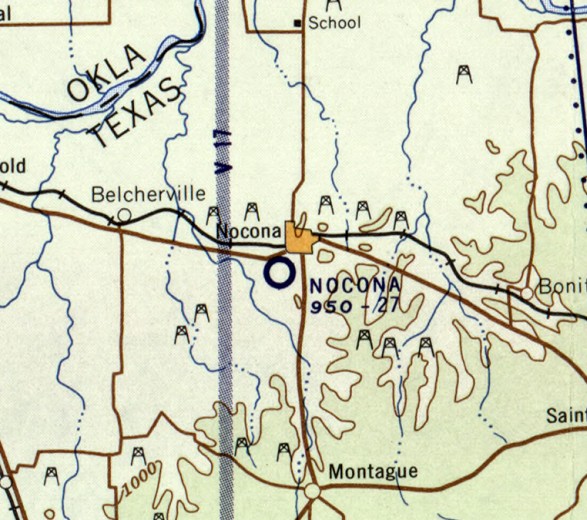
Nocona Airport, as depicted on the January 1957 Dallas Sectional Chart (courtesy of Ron Plante).
Photo of the airfield while in use has not been located.
This small general aviation airport was evidently established at some point between 1955-57,
as it was not yet depicted on the February 1955 Dallas Sectional Chart.
The earliest depiction which has been located of Nocona Airport was on the January 1957 Dallas Sectional Chart (courtesy of Ron Plante),
which depicted Nocona as having a 2,700' unpaved runway.
Gary Hiland recalled, “My grandparents lived in Nocona & I visited there often in the 1960s-80s. We used to drive by the airport often.
In all that time, I can only remember seeing 1 airplane based there. In the early to mid-1960s there was a single plain metal hangar about where the parking pad is shown.
One time I saw it with the doors open & there was a low-wing single-engine plane inside.”
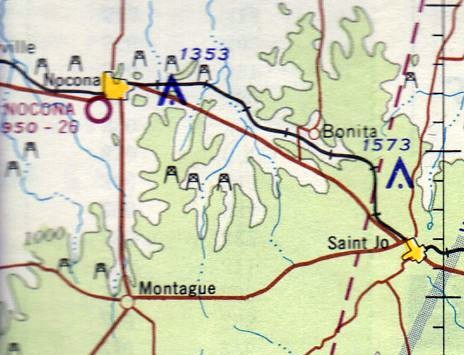
The last aeronautical chart depiction which has been located of Nocona Airport was on the July 1966 Dallas Sectional Chart,
which depicted Nocona as having a 2,600' unpaved runway.
The earliest photo which which has been located of Nocona Airport was a 1966 aerial view.
It depicted Nocona Airport as having a northwest/southeast unpaved runway, with no buildings or other improvements visible.
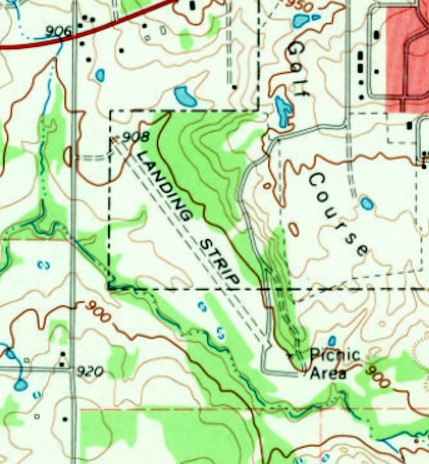
The 1968 USGS topo map depicted Nocona Airport as a single unpaved northwest/southeast runway,
labeled simply as “Landing Strip”. There were no buildings depicted on the airport.
Gary Hiland recalled, “The hangar was there for several years & then the siding was removed & the frame stood alone for several more years.
During the 1970s I flew into Nocona quite a few times as a passenger on both a Piper Navajo & a Beech King Air C90.
Later the company upgraded to a Super King Air & we could no longer safely use Nocona.”
A 1981 aerial view depicted Nocona Airport as having a northwest/southeast runway.

The 1982 USGS topo map depicted “Nocona Airport” as having gained a paved runway & ramp at some point between 1968-82.

The earliest photo which has been located of Nocona Airport was a 1995 USGS aerial view looking east.
It depicted Nocona as having a paved Runway 14/32, with a paved ramp, and a segmented circle. There were no buildings or aircraft visible at the airport.

Nocona Airport was evidently closed (for reasons unknown) at some point between 1982-2014,
as a 2014 aerial view showed the runway markings were gone, the pavement was badly deteriorated, and a stream had cut through the southern end of the runway pavement.
Gary Hiland reported, “I don't know why the airport was abandoned but I would suspect it was from lack of use.”
Nocona Airport was depicted as an abandoned airfield on the 2016 Dallas Sectional Chart.
Bryan Fair reported in 2017, “Me & neighbor had made plans to fly there for breakfast a year ago... and we found out it had been deactivated.”
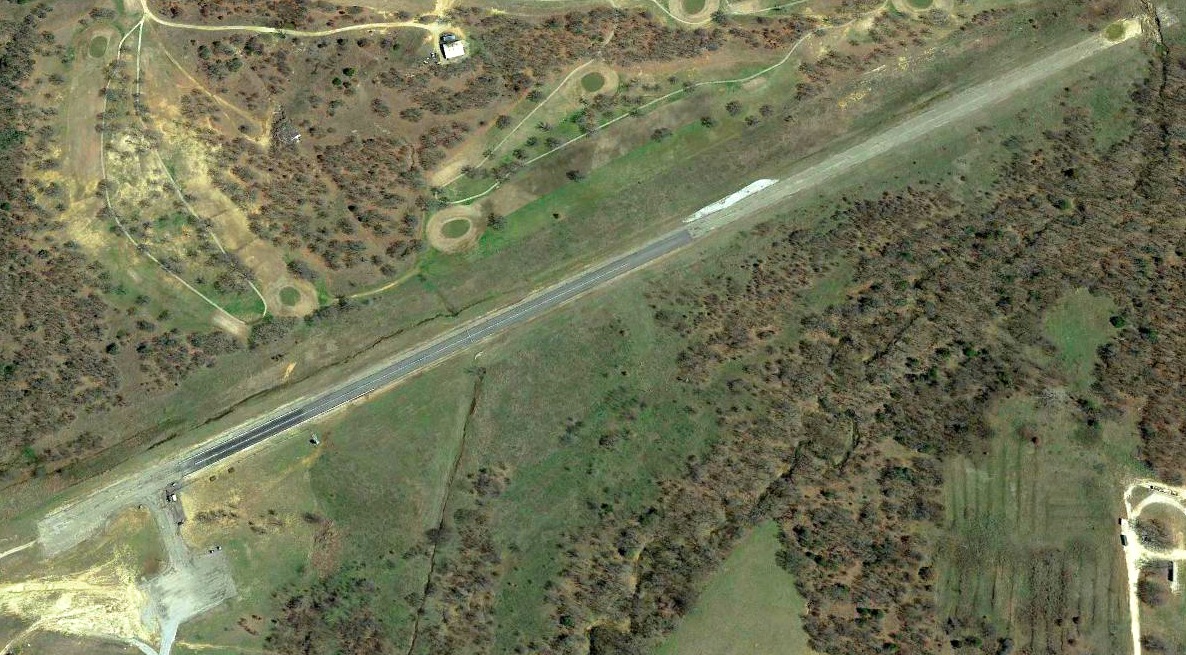
A 2019 aerial view looking east at Nocona Airport shows that, as Ryan Patrick observed, at some point between 2014-2019 it was repurposed as a dragstrip.
As of 2023, street maps label the site of Nocona Airport as the Indian Valley Raceway.
The site of Nocona Airport is located southeast of the intersection of Route 82 & Airport Road, appropriately enough.
Thanks to Bryan Fair for pointing out this airfield.
____________________________________________________
33.87, -98.55 (Northwest of Fort Worth, TX)

A 1918 aerial view showing the long row of hangars at Call Field.
In April 1917 after the United States' entry into World War I, the Army announced its intention of establishing a series of camps to train prospective pilots.
Frank Kell of Wichita Falls organized an effort to attract the Army to the city.
In June 1917, the Department of War sent a cadre of officers to the Wichita Falls area to survey sites for an aviation school.
The group decided on a location about 5 miles southwest of Wichita Falls.
By 8/17/17, Kell & others successfully raised $35,000
and had a commitment from the Missouri, Kansas & Texas Railroad to extend tracks to the proposed site of the camp.
On August 27 construction began of the training field began.
It was one of 32 Air Service training camps established after the United States entry into World War I.
Call Field was named for 1st Lieutenant Loren Call who was killed in an airplane accident on 7/8/13.
Call Field had 46 buildings, which included 12 hangars that housed 4-8 planes each, a hospital, and 6 barracks that held 175 men each.
In May 1918 four additional hangars & a row of lofts to hold carrier pigeons were built.
It covered over 700 acres & could accommodate up to 1,000 personnel.
Dozens of wooden buildings served as headquarters, maintenance, and officers’ quarters.
Enlisted men had to bivouac in tents.
In November, when 85% of the work was completed, Maj. J. B. Brooks arrived to inspect the facilities.
On November 10 he was named commander.
On November 29 the 163rd Aero Squadron, equipped with 6 Curtiss JN-4 Jenny trainers arrived from Kelly Field, and the field had 600 pilots by late December.
Most of the JN-4 Jennys to be used for flight training, however, were shipped in wooden crates by railcar.
On 1/15/18 the army gave final approval of Call Field.
Call Field served as a base for flight training for the United States Army Air Service.
In 1918, flight training occurred in 2 phases: primary & advanced.
Primary training took 8 weeks & consisted of pilots learning basic flight skills under dual & solo instruction with a student capacity of 300.
After completion of their primary training, flight cadets were then transferred to another base for advanced training.

A 1918 aerial view showing the long row of hangars at Call Field taken from one of its Standard J-1 biplanes.
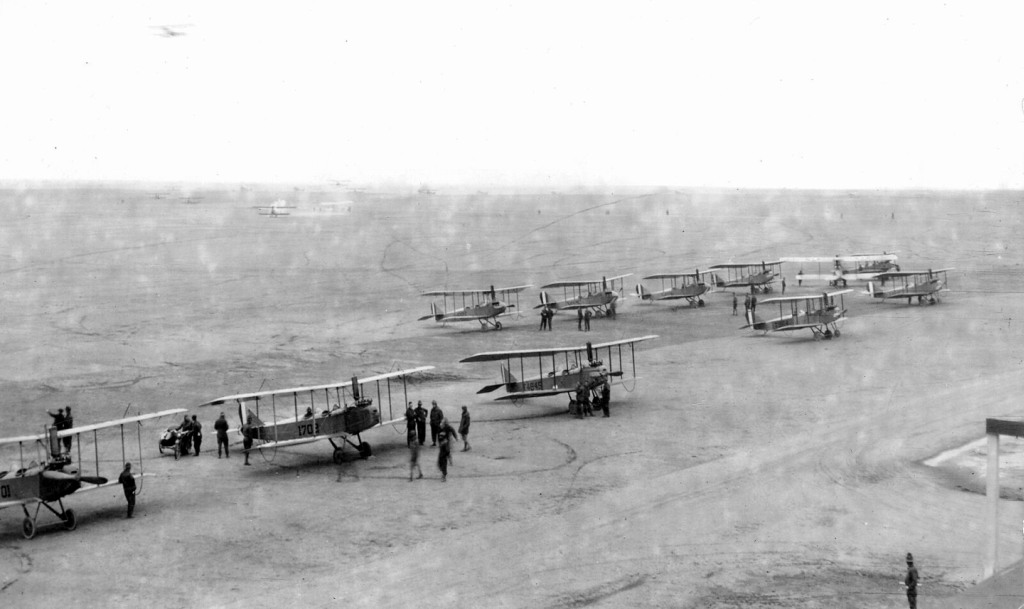
A circa 1918 U.S Army photo of a group of Standard J-1 biplanes at Call Field.
Training units assigned to Call Field were: Post Headquarters, Call Field, November 1917-October 1919.
164th Aero Squadron, November 1917, re-designated as Squadron "A", July-November 1918.
192nd Aero Squadron, December 1917, re-designated as Squadron "B", July-November 1918.
198th Aero Squadron, December 1917, re-designated as Squadron "C", July-November 1918.
Squadron "D", transferred from Barron Field, TX, September-November 1918.
Squadron "E", transferred from Carruthers Field, TX, September-November 1918.
Flying School Detachment (Consolidation of Squadrons A-E), November 1918-November 1919.
Service units trained at Call Field were: 73rd Aero Squadron (II), March-July 1918; Deployed to American Expeditionary Forces, France.
74th Aero Squadron, March-August 1918; Transferred to Hazelhurst Field, NY.
Linda Pugliano reported, “My grandfather Harold Davis was a pilot at Call Field.”
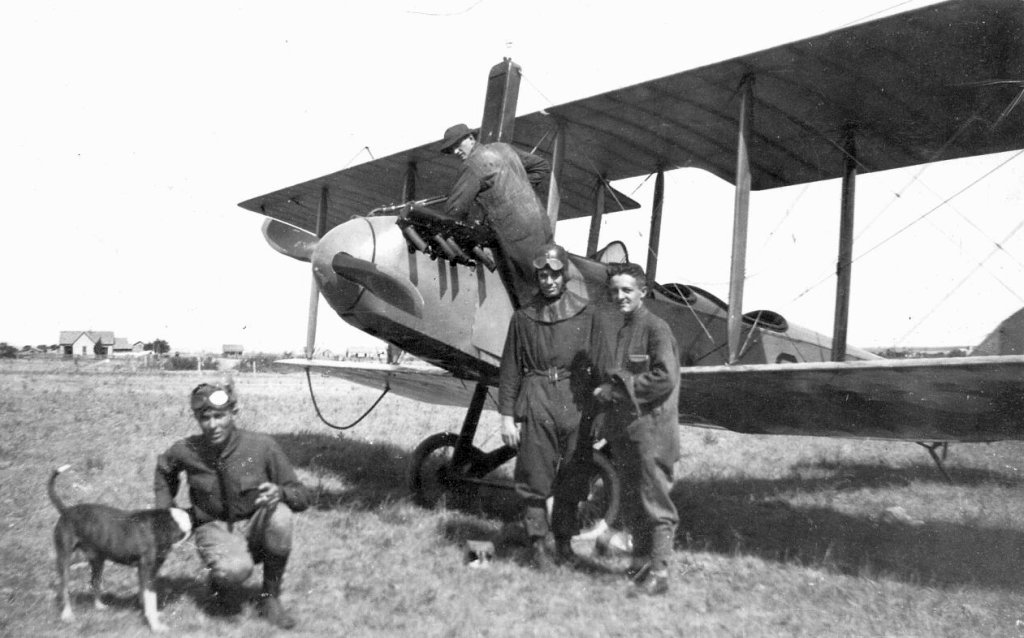
A circa 1918 U.S Army photo of crew & a dog in front of a Standard J-1 biplane at Call Field.
During its operation 3,000 officers, cadets, and enlisted men were stationed at Call Field, and 500 officers received their wings there.
Two squadrons left the training facility for overseas duty.
Thirty-four men lost their lives during training exercises, the smallest number of fatalities of any U.S. military aviation training center up to that point.
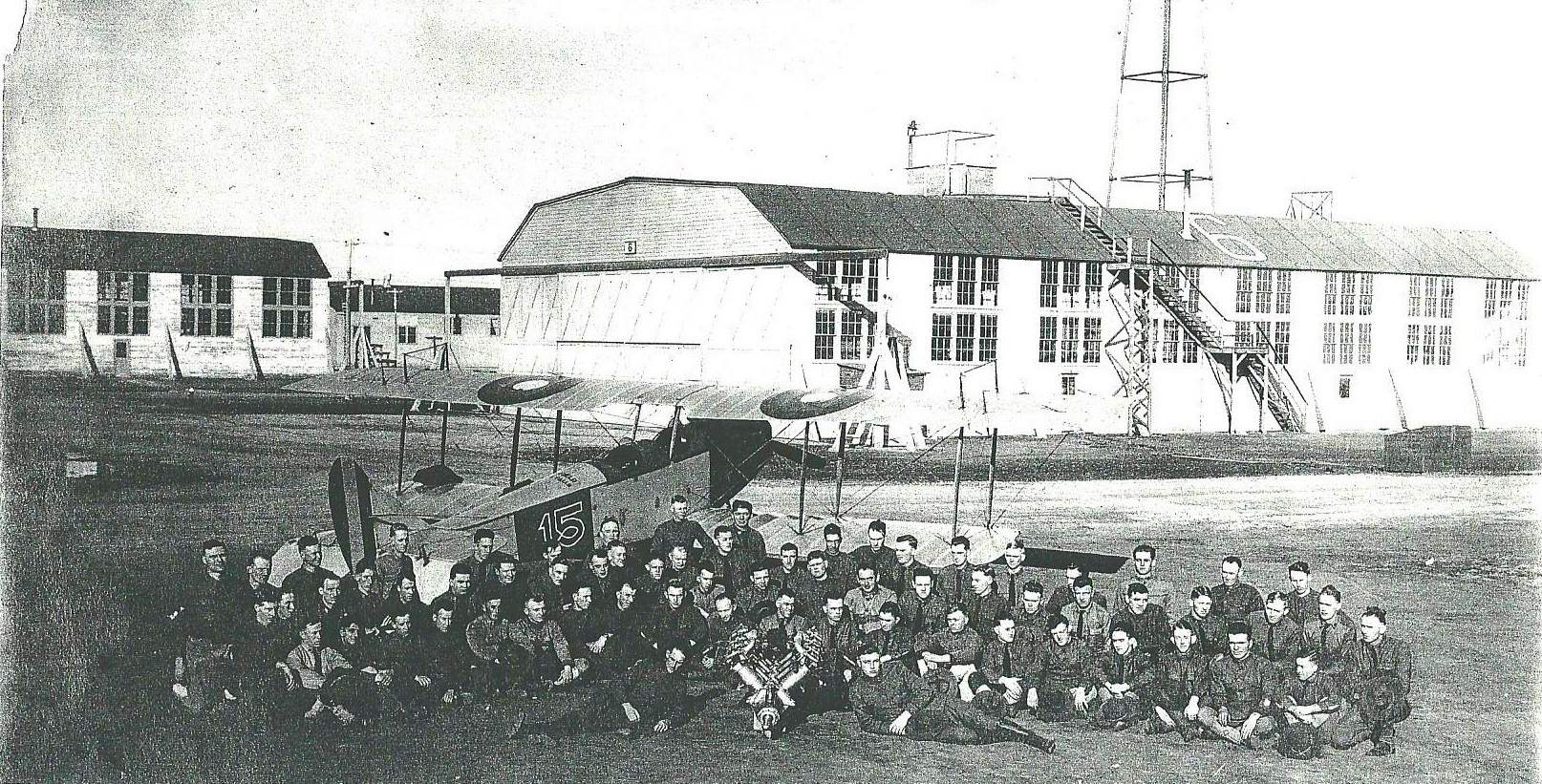
A circa 1918-19 photo of a group in front of a biplane & hangars at Call Field.
With the sudden end of World War I in November 1918, the future operational status of Call Field was unknown.
Many local officials speculated that the U.S. government would keep the field open
because of the outstanding combat record established by Call-trained pilots in Europe.
Locals also pointed to the optimal weather conditions in the North TX area for flight training.
Cadets in flight training on 11/11/18 were allowed to complete their training, however no new cadets were assigned to the base.
Also the separate training squadrons were consolidated into a single Flying School detachment,
as many of the personnel assigned were being demobilized.
Finally, flight training activities ceased on 11/8/19.
In December 1919 Call Field was deactivated as an active duty airfield, however, and a small caretaker unit was assigned to the facility.
The War Department had ordered the small caretaker force to dismantle all remaining structures & to sell them as surplus.
In 1920 Ernest Hall, a former instructor at Call Field, operated a flying school at the facility.
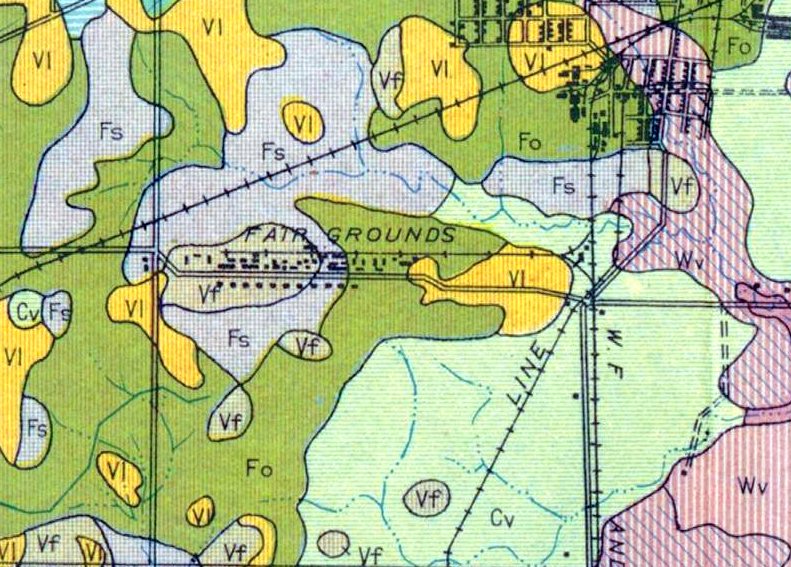
A 1920 Agriculture Department Soil Map (courtesy of Randy Gilbert) depicted the row of hangars of Call Field, but labeled it as “Fair Grounds)”.
The Wichita Polo Club briefly used a portion of Call Field for its polo field.
The 1932 Dallas Sectional Chart did not depict Call Field.
In 1937 the Wichita Falls Junior Chamber of Commerce & American Legion
erected a small marker near the gates of the old field in memory of the 34 men who were killed during training.
For a number of years the site was the scene of memorial services by the Call Field Veterans Association.
The 1958 USGS topo map depicted a number of small buildings along Call Field Road, with a large open field to the north.

A 3/4/13 aerial view showed no trace remaining of Call Field.
The site of Call Field is located west of the intersection of McNiel Avenue 180 & Call Field Road, appropriately enough.
____________________________________________________
Sheppard AF Helicopter Training Annex #2, Iowa Park, TX
34, -98.63 (Northwest of Fort Worth, TX)
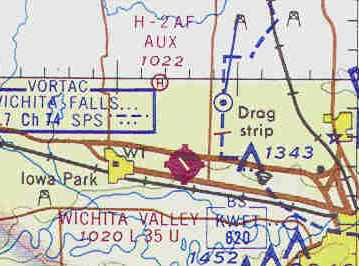
“H-2 AF Aux”, as depicted on the July 1968 Dallas Sectional Chart (courtesy of Chris Kennedy).
Photo of the airfield while in use has not been located.
This site might also have originally been home to a First World War auxiliary field to Call Field (in Wichita Falls), called Iowa Park.
Nothing airfield-related was recognizable at this location on a 1953 aerial photo.
This small annex of nearby Sheppard Air Force Base was assigned in 1966,
and was apparently used to support Air Force helicopter training at that base.
Sheppard Helicopter Annex #2 was not yet depicted on the February 1968 Dallas Sectional Chart.
The earliest depiction of the Sheppard Helicopter Annex #2 which has been located
was on the on the July 1968 Dallas Sectional Chart (courtesy of Chris Kennedy).
It depicted “H-2 AF Aux” as a heliport.
Larry DeVore (who was stationed at Sheppard AFB from 1968-71 as a HH-43B mechanic)
reported that "Annex #2 I think was used by the UH-1Fs & CH-3Cs."
Larry DeVore also recalled that Sheppard Helicopter Annex #1 was located in Grandfield, OK, and was used by HH-43Bs.
"The site (Annex #1) had a small metal building & a short paved runway, as the HH-43Bs could do rolling takeoffs & landings.
We had to either fly up or ride in the fuel truck as we had to refuel the helicopters after the training was over."
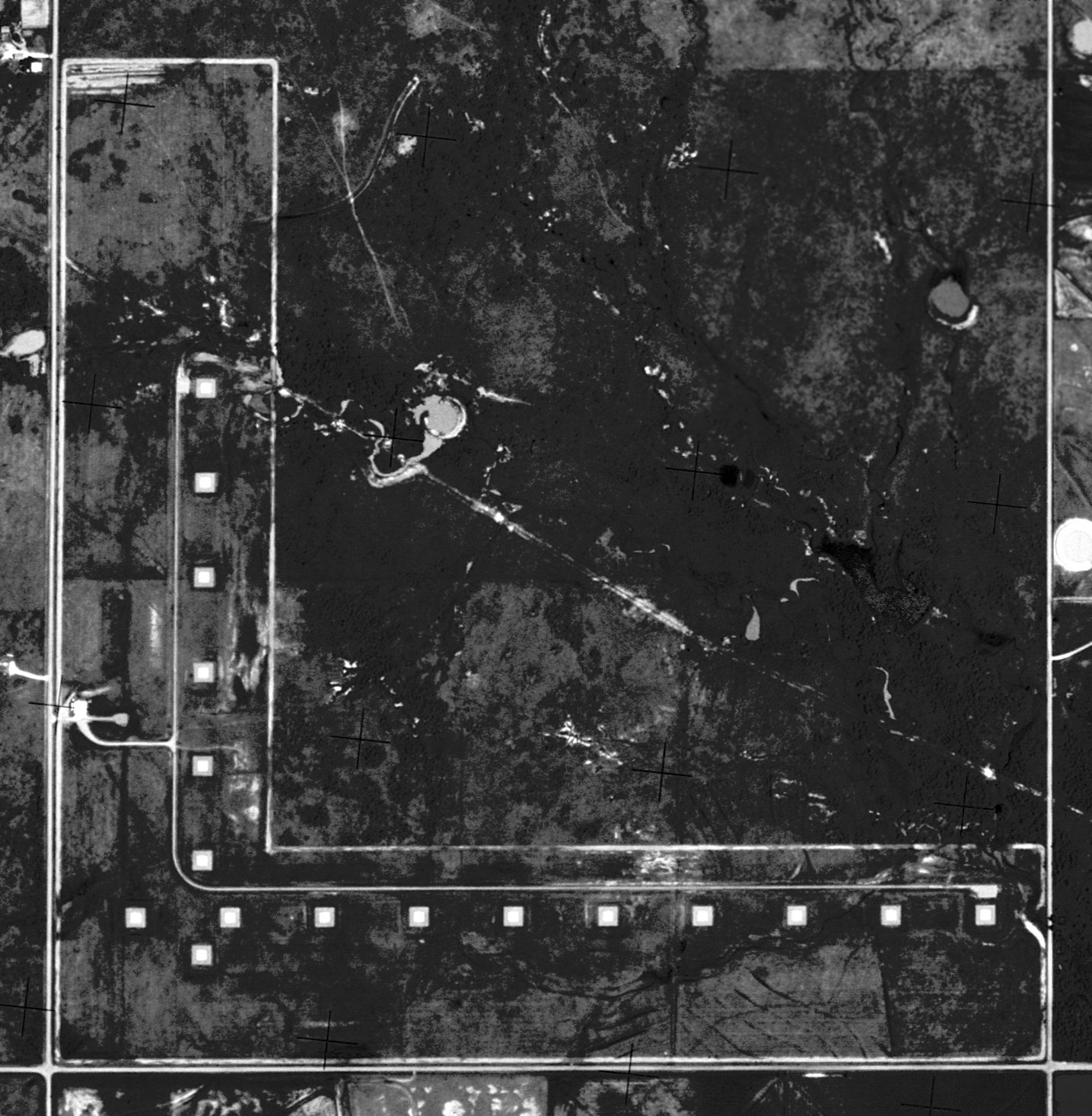
The earliest photo which has been located of the Sheppard Helicopter Annex #2 was a 5/2/70 USGS aerial view.
It depicted 2 rows of a total of 17 helicopter landing pads, each a 90' square of concrete.
There were no helicopters visible on the field.
Sheppard AF Helicopter Training Annex #2 was disposed of in 1972.
The property was labeled "Sheppard Air Force Base Small Arm Range Annex" on the 1972 USGS topo map.
"H-2 AF Aux" was still depicted as an active heliport on the 1978 DFW Sectional Chart (courtesy of Ray Brindle).
The Sheppard Annex #2 was not depicted at all on the 1979 or 1983 USGS topo maps.
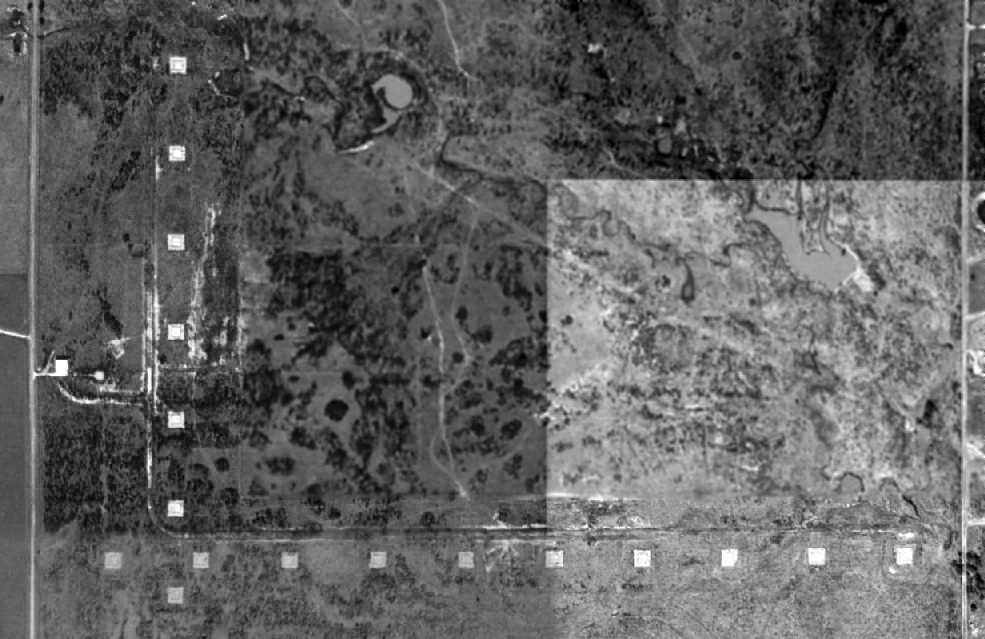
A 1/29/95 USGS aerial view of Sheppard AFB Annex #2 showed the 17 helicopter landing pads remained intact.


A 12/26/11 aerial photo showed the helicopter facilities at Sheppard AFB Annex #2 to remain unchanged.
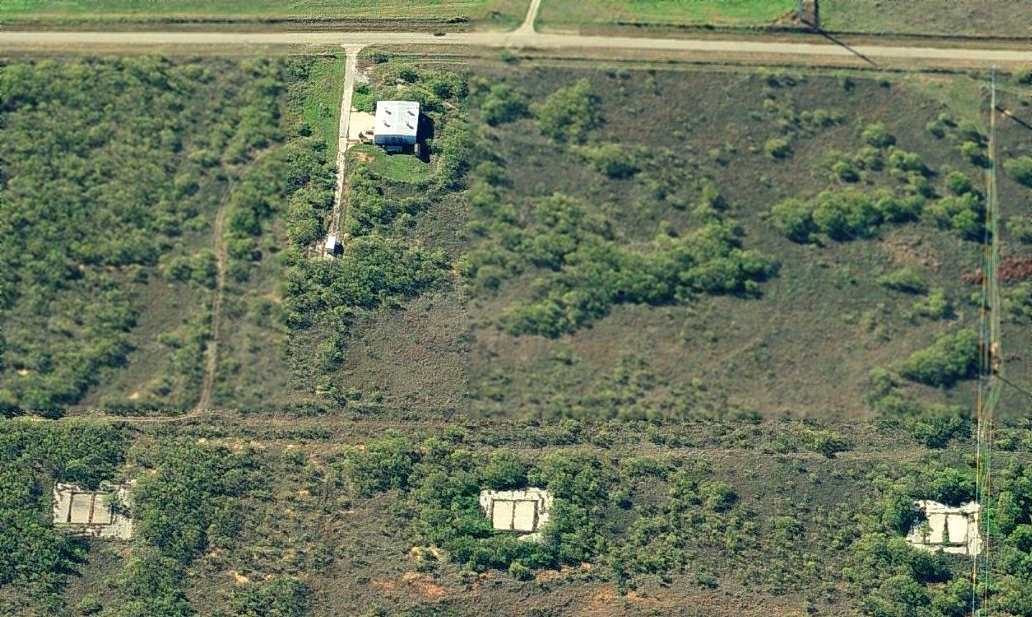
A circa 2011 aerial view looking west at the 3 of the helicopter landing pads & the support building on the west side of Sheppard AFB Annex #2.
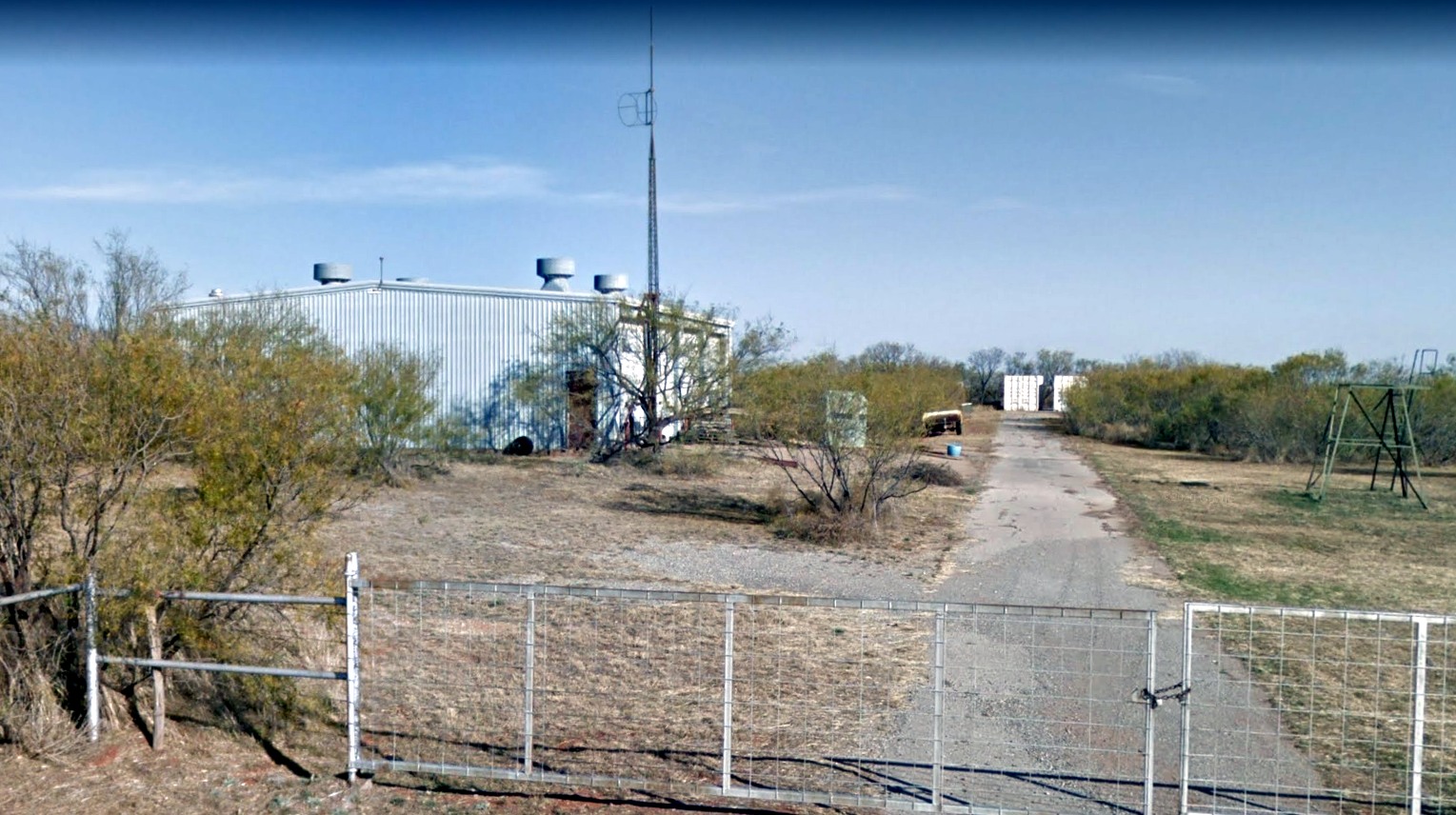
A December 2012 photo looking east at a support building with a windsock mount on a pole on the west side of the Sheppard AFB Annex #2 property.
Sheppard AFB Annex #2 is located on the east side of Peterson Road, 3 miles northeast of Iowa Park, TX.
____________________________________________________
Since this site was first put on the web in 1999, its popularity has grown tremendously.
If the total quantity of material on this site is to continue to grow,
it will require ever-increasing funding to pay its expenses.
Therefore, I request financial contributions from site visitors,
to help defray the increasing costs of the site
and ensure that it continues to be available & to grow.
What would you pay for a good aviation magazine, or a good aviation book?
Please consider a donation of an equivalent amount, at the least.
This site is not supported by commercial advertising –
it is purely supported by donations.
If you enjoy the site, and would like to make a financial contribution,
you
may use a credit card via
![]() :
:
Please consider checking the box to make a monthly donatation.
For a mailing address to send a check, please contact me at: paulandterryfreeman@gmail.com
If you enjoy this web site, please support it with a financial contribution.
please contact me at: paulandterryfreeman@gmail.com
If you enjoy this web site, please support it with a financial contribution.
____________________________________________________
This site covers airfields in all 50 states.